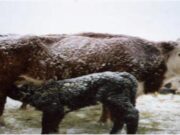
Popandeer Kour (Ph.D. Scholar, Department of Veterinary Gynaecology and Obstetrics)and Dr. Bilawal Singh (Assistant Professor, Department of Veterinary Gynaecology and Obstetrics) Guru Angad Dev Veterinary and Animal Sciences University, Ludhiana, Punjab, India
Introduction
The initial hour following a calf’s birth is a pivotal moment in the calf’s life. During this period, several crucial actions should be taken to ensure the calf’s well-being:
1. Clearing Airways: It’s essential to cleanse the nostrils and mouth of the calf to facilitate unobstructed breathing. This step helps prevent potential respiratory issues, ensuring the calf breathes easier.
2. Maternal Care: Allowing the mother cow to lick the calf clean serves multiple purposes. This maternal attention promotes blood circulation in the calf’s body, contributing to its overall health. Additionally, it prepares the calf for those significant milestones of standing up and walking.
3. Umbilical Cord Care: Approximately 2 inches from the base of the umbilical cord, securely tie it with a thread and then carefully cut the remaining portion using a clean instrument. To minimize the risk of infection, the navel should be dipped in a tincture of iodine solution with a concentration of 7% or higher. This treatment should be repeated after 12 hours. The use of teat dip or weaker iodine solutions should be avoided, as a poorly maintained navel can become a gateway to serious infections.
4. Colostrum Feeding: Within the first two hours of birth, newborn calves should receive 2 liters of colostrum, followed by an additional 1-2 liters (adjusted according to the calf’s size) within the first 12 hours. Colostrum, the first milk from the mother, is rich in antibodies that grant the calf essential immunity. It’s crucial to understand that providing colostrum after 24 hours of birth is less effective in conferring immunity. To safeguard the calf from diseases, it must obtain sufficient colostrum for the first three months of its life, making it a literal “passport to life.”
5. Hand-Feeding for Assurance: Hand-feeding newborn calves is recommended to ensure that each calf receives an adequate and measured quantity of colostrum. Some calves may not nurse sufficiently from their mothers, so this practice guarantees that the farmer knows precisely how much colostrum each calf receives.
6. Deworming and Vaccination: As the calf matures, it’s crucial to maintain its health through regular deworming and vaccination. Monthly deworming should commence within 10-14 days of age and continue until the calf reaches six months. This regimen helps control internal parasites that can negatively affect the calf’s health. Consult with a veterinarian when the calf reaches three months of age to discuss vaccination options. Vaccination is a pivotal measure for protecting the calf from an array of diseases, forming an essential part of preventive healthcare.
7. Calf Starter Feed for Growth: Introducing a calf starter feed, typically from the second to eighth week of age, is recommended to enhance growth and stimulate early maturity in the calf. This supplementary feed plays a key role in supporting the calf’s overall development.
These guidelines encompass various aspects of caring for newborn calves, from the critical first hour following birth to the ongoing management of their health and nutrition. Diligent adherence to these practices is essential for ensuring the well-being of cattle on a farm. Seeking advice from a veterinarian or agricultural expert, tailored to specific farm conditions, is always a prudent course of action.
Calving Pen
A calving area, often referred to as a calving box or stall, is a crucial component in the management of cattle during the calving process. Here are the key points about the design and location of a calving area:
1. Dimensions and Ventilation: The calving area should be designed as a loose box or stall and be spacious enough, typically measuring 3 meters by 4 meters, which equals 12 square meters in size. Adequate ventilation is essential to ensure good air quality for the cow and calf. Proper air circulation helps maintain a comfortable and healthy environment.
2. Lighting: Sufficient lighting is crucial within the calving area. This allows for better visibility and is especially important during nighttime calving events. Adequate lighting aids in monitoring the cow and calf, ensuring a safe and successful calving process.
3. Protection and Isolation: The primary purpose of a calving area is to provide a safe and protected space for the cow and her calf during the calving process. This enclosure prevents threats from other cows, such as aggression or interference, which can occur when multiple cows are present in the same space.
4. Proximity to Attendant Quarters: It’s advantageous to consider the location of the attendant’s living quarters in relation to the calving pen. Having the attendant’s quarters in close proximity to the calving area can be beneficial, particularly for nighttime calving.
Management After Calving
● Udder and hind quarter should be washed with lukewarm water containing an antiseptic solution of potassium permanganate lotion and dried with clean cloth. Cows may be milked to alleviate udder pressure.
● I f day old weaning is not practiced the calf can be allowed to remain with the mother in the calving pen for 7 to 10 days. Otherwise the calves can be removed immediately to calf pen. The maternal instinct is more, cow’s eyes can be blindfolded before the calf is removed. The placenta is to be expelled within 12 to 24 hours after parturition. if it is not expelled in 24 hours, seek the help of a Veterinarian be removed manually.
● The body temperature should be noted prior to manual removal. Attempts should be made systemically to minimize fever in the case of pyrexia. Systemic infection can otherwise be identified. Cows should be closely watched for symptoms of any metabolic diseases, such as milk fever, grass tetanus, ketosis, acidosis, and should be promptly treated.
Colostrum Feeding
The first milk secreted after parturition is Colostrum. It contains significant quantities of Gama globulins, which are nothing but anit-bodies formed by the cow against antigens throughout her lifetime. Absorption of these antibodies gives the calf a passive immunity umbrella. Colostrums is highly fortified source of nutrient having 7 times the protein and twice the total solids of normal milk, thus it gives an early boost in portion and solid intake. It contains higher amount of minerals and vitamin A which are essential to combat disease. Ingestion of these through colostrums substantially increase the calf’s survivability. Colostrum give a laxative effect which is helpful in expulsion of (first faces). The cows should be vaccinated against contagious and infectious diseases which help to increase the quantity and quality of Gama globulins in colostrums. Similarly, colostrums of mature cow possess large quantities of Gama globulins because they have greater chance of exposure to many infections. The Gama globulins must be absorbed as such across the intestinal wall into blood stream without being broken down into the constituent peptides or amino acids. In the first few hours of life, this permeability is rapidly lost. Many studies have shown that within the first 1-2 hours of life, these globulins migrate through the intestinal wall at the highest speeds. Bringing this into context. In the first 15-30 minutes, it will be very useful to feed the colostrum, followed by a second dose in around 10-12 hours. The absorptive cells lining the small intestine are immature at birth. In this stage they indiscriminately take up large molecules like immunoglobins. As the calf grows older hour by hour, there is a transition of epithelia cells of small intestine from immature type to mature type which cannot allow large protein molecules. As the more and more cells mature the capacity of the calf to absorb immunoglobins diminishes proportionately until ‘closure’ when no more absorption can take place. This phenomenon is called ‘gut closure’. Concentration of antibodies at ‘closure’ is directly related to the disease resistance of the calf. If the calf had only consumed a small amount of colostrum immunoglobins at closure, the declining concentration soon places the calf in a critical immune position. This raises morbidity and also contributes to calf mortality. The sum of colostrum to be supplied is 1/10th of the weight of the body.
15-30 minutes of life – 5-8 % of body weight
10-12 hours of life – 5-8 % of body weight
2nd day – 10% of body weight 3rd day – 10% of body weight
Excess colostrums can be milked out daily otherwise the calves can drink in excess and results in calf scour. The excess colostrums can be stored by refrigeration and can be used to other calves or orphan calves. Colostrums can also be freezed and stored indefinitely. Colostrums can also be fermented naturally and stored and can be used for 5-7 days. Colostrum substitute: colostrum substitute may be used in case of non- availability due to accidental death of the mother or agalactia colostrum substitute. It can be prepared by combining one litre of milk and 30 ml of castor oil with 2 whole eggs. They have to be served three times a day.
Weaning
Weaning is the process of gradually making a calf independent of its mother’s milk. In the context of early weaning, a different approach is taken where the cow is not allowed to suckle its calf. Instead, the following steps are typically followed:
1. Complete Milking of the Cow: The first step in early weaning is to completely milk out the cow. This ensures that there is no milk left in the udder, reducing the calf’s access to its mother’s milk.
2. Feeding Whole Milk or Skim Milk to the Calf: To compensate for the lack of access to the cow’s milk, the calf is provided with whole milk or skim milk. This milk is typically formulated to meet the nutritional needs of the calf and is often delivered via a bottle or other feeding methods.
Early weaning is commonly practiced for various reasons, including better control over the calf’s diet and development, improved management of the cow’s milk production, and specific breeding or health-related considerations. By implementing this approach, the farmer can ensure that the calf receives the necessary nutrients for its growth and development while gradually transitioning it to a diet that doesn’t rely on the cow’s milk.




















